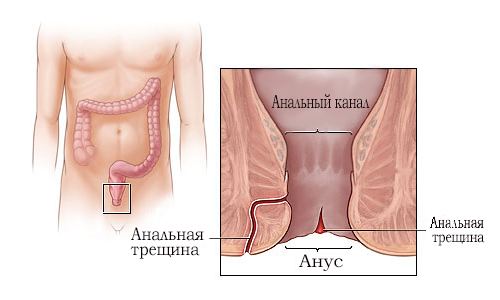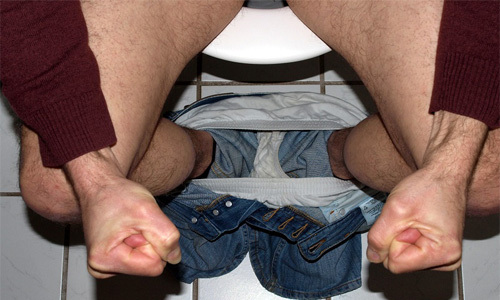Anterior cracks occur in patients in proctologic practice on a par withwith inflammation of the rectum and hemorrhoids. Although the pathology affects more often the female population, men also get a lot from it. An anal fissure is a defect in the mucous membranes in the anus. Localized similar lesions predominantly on the posterior wall of the intestine, although there are such clinical cases( predominantly in the female), when a sagging defect is formed on the anterior intestinal wall. If the pathology is combined with hemorrhoids, then its location can be localized along the sides of the anal canal.

What is this disease?
Anal fissure is a rupture of the mucous layer of the anal opening. In this case, damage to tissues, which are many blood vessels and highly sensitive nerves. This explains the special soreness and increased bleeding of such ruptures.
Warning! If the anal canal rupture is not treated within a month, the pathology will pass into a chronic condition, which threatens with a number of complications.
The anus of the anus can be of the nature of an acute lesion or become a chronic pathological form. The acute type of pathology looks like a rupture. If the disease has passed to the stage of chronic damage, the anal fissure takes the form of an injured deep wound, the condition of which is complicated by swelling and inflammatory processes at the site of the rupture.
The length of such damage can be insignificant and be only a couple of millimeters, but there are also 2-centimeter ruptures. If the crack heals within 4-6 weeks, then it is classified as acute disease, all lesions, healing which lasts longer than one and a half months, are considered as chronic pathological forms.
Why there are such defects
There are several main reasons, most often leading to the appearance of a rupture:
- Hemorrhoids. In the process of emptying the intestine, hemorrhoid cones are easily amenable to damage. Together with the blood-stasis, thrombosis and impaired blood supply, weakening the walls of the anal process, this leads to damage;
- Inflammatory conditions of the gastrointestinal tract. Anal fissure is often triggered by gastritis, cholecystitis, constipation or diarrhea, which contribute to the penetration of bacteria into erosive formations and irritating mucous membranes;
- Injuries. The rear passage can be injured by overly dense feces characteristic of constipation. Often, the mucous membranes of the rectum are injured as a result of anal sexual contact;
- Intestinal spasm. If the intestines are in a tonus for a long time, there is a violation of its innervation properties and bleeding, which contributes to the chronization of the rupture;
- Heavy physical activity leads to constant straining, which contributes to increased intra-abdominal pressure, the occurrence of hemorrhoids and ruptures in the rectum.
- Anal fissure is able to form due to lack of mobility and hypodynamia, which provoke a violation of low blood circulation and blood-stasis;
- The abuse of laxatives leads to irritation of the anus and contributes to the occurrence of injuries;
- Weakened pelvic muscles.
- Glistular invasion. Eggs of parasites cause the appearance of severe itching in the anus, leading to swelling and inflammation of the anus. When combing, you can injure a weakened shell, which will additionally be traumatized with each emptying of the intestine.
Cracking mechanism
The process of crack formation is quite simple: the permanent traumatic effect of the folds of the anal mucosa causes damage. Such a rupture bare the nerve endings, which leads to spasm of the anus and characteristic soreness in the emptying of the intestine.

Further constipation and too hard stools continue to injure the mucous membrane, which causes persistent pain symptoms and contraction of the anal muscles. A combination of such conditions interferes with the regeneration of damaged tissues, and pathogenic intestinal bacteria constantly infect the injured mucosa, which is in a constantly inflamed condition.
Important! In the absence of treatment, the depth of the crack increases, and its edges become thicker, which provokes an increase in the intensity of the pain syndrome. As a result, the pathological process is chronicized.
If hemorrhoids develop further, the situation becomes even worse, because the inflammation of the hemorrhoids is accompanied by a disturbed blood supply in the anus, which significantly inhibits the healing processes. Even if the stool comes back to normal and there is remission, there is no guarantee that in a few months or even years with severe diarrhea or constipation the anal fissure will not appear again. Therefore, such damage requires compulsory treatment.
How to determine that a crack is formed
It is not difficult to detect the formation of a rupture, because its clinic is quite characteristic and is based on three signs:
- Severe tenderness in the anal area - a similar complaint is usually the main one in case of a rupture of the mucosa of the anus. Pain syndrome occurs with defecation, for a long time disturbing the patient and after intestinal emptying. In some patients soreness is given to the groin, coccyx and perineum. Sometimes soreness can worsen after prolonged sitting;
- Symptoms of bloody discharge from the anus are usually minor, manifested by a few scarlet drops on toilet paper or veins in the stool. If such discharge becomes abundant, then, most likely, the anal fissure is complicated by concomitant pathological conditions such as tumor-like formation or hemorrhoids;
- Involuntary compression of the anus( spasm of the sphincter) after bowel movement. Such spasms are reflexive, can bother for several minutes or persist until the next trip to the toilet. Muscular contraction due to severe pain syndrome causes the deterioration of blood supply, increase in pain intensity and slowing down of regenerating processes.
If to all else the patient has hemorrhoids, then the clinical picture is complemented by the proliferation of hemorrhoid cones. Often patients, fearing the appearance of pain, try to postpone defecation, which provokes strong constipation. Severe pains lead to discomfort and irritability, negatively affect the patient's sleep and can even provoke problems with urination.
The more dangerous the disease, the possible complications of
The long absence of therapeutic measures leads to the chronicity of the pathology, as a result of which the anal fissure provokes the development of a dangerous complication - paraproctitis is an inflammation with a purulent abscess in the rectal tissues. Such complications are not so common and are only eliminated through surgical intervention.
Much more often the rupture of the anal passage is accompanied by severe itching, which causes a lot of uncomfortable sensations, and proctitis, which is an inflammation of the intestinal mucosa( in the rectum).Sometimes, the fissures of the anus are complicated by bleeding, leading to the development of iron deficiency anemia. In rare cases, the crack is complicated by an upward inflammation of the prostate gland.
How to treat a rupture of anal mucosa
The main directions in the elimination of pathology are relief of pain, normalization of the stool, removal of sphincter spasm, regeneration of the rupture. The therapeutic measures taken are conservative or involve the intervention of a surgeon.
Conservative treatment
Conservative techniques are considered to be sufficiently effective in treating anal mucosal gaps. Appeal to the proctologist within the first week after the formation of the anal fissure, promotes effective and rapid healing of the rupture through medications.
A significant component of conservative treatment is a dietary diet that will facilitate the process of bowel evacuation and activate its activity. Such a diet assumes a balanced use of nutritious dishes, sour-milk and plant products. But alcohol, sharp and strongly flavored dishes are recommended to be excluded, since they negatively affect the intestinal mucosa.
Good to know! With persistent constipation, it is recommended to take fish oil, Prelaxane, Dufalac, Linex, Lactobacterin, to eat more plant foods like beets, carrots, apples, prunes or dried apricots.
Drug treatment involves the use of local and general medicines. Local procedures include:
- Crack cracking with nitroglycerin ointment;
- Warm manganese sessile baths( 10 minutes each);
- Microclysters with antiseptic solutions;
- Rectal suppositories and ointments with analgesic substances like anesthesin, lidocaine or novocaine;
- Lubrication with sea buckthorn oil to accelerate regeneration;
- Botox, when used locally, relieves spasms.
In severe constipation, laxative drugs are prescribed, and for the removal of a spasm, the use of calcium blockers like Nifedipine or Diltiazem, spasmolytics( No-Shpa) is indicated. Often the complex of therapy includes physiotherapeutic procedures: infrared radiofrequency, laser coagulation, drug blockade, etc.
Surgical intervention
Surgical intervention is resorted to when the anal fissure is too deep, it reaches the chronic stage of development, its edges become cicatrical, there is always a sphincter spasm, conservative therapy does not give the desired result. Operative treatment involves the procedure of excision of the anal fissure.
Depending on the complexity of the operation performed, the patient is in a hospital from several hours to a week. Complete healing of the fracture is observed after a month after the operation.
If pathology is complicated by inflammation of the hemorrhoids, then a complex operation is carried out, including excision of the fracture and hemorrhoidectomy. Any method of treatment is selected by the proctologist on an individual basis in accordance with the stage of development of the crack, with the presence of concomitant complications and other factors. The main thing is not to delay with the address to the doctor, only so it will be possible to exclude the probability of complications development.
Preventative measures
To prevent anal fissure, you should adhere to some recommendations:
- Observe intimate hygiene;
- Eat foods that exclude diarrhea or constipation, adhere to the principles of proper nutrition;
- Active life, periodic visits to the gym or fitness;
- Elimination of alcohol abuse;
- Exclusion of unconventional sexual relations;
- Timely anti-hemorrhoid treatment.
Timely conservative therapeutic measures lead to complete recovery in more than 70% of clinical cases. If the therapy is chosen incorrectly, the patient is engaged in self-medication or does not take any measures at all, these actions can lead to the chronicization of the pathological process and the need for surgical treatment. Surgical intervention in most clinical cases leads to complete recovery of the patient.



